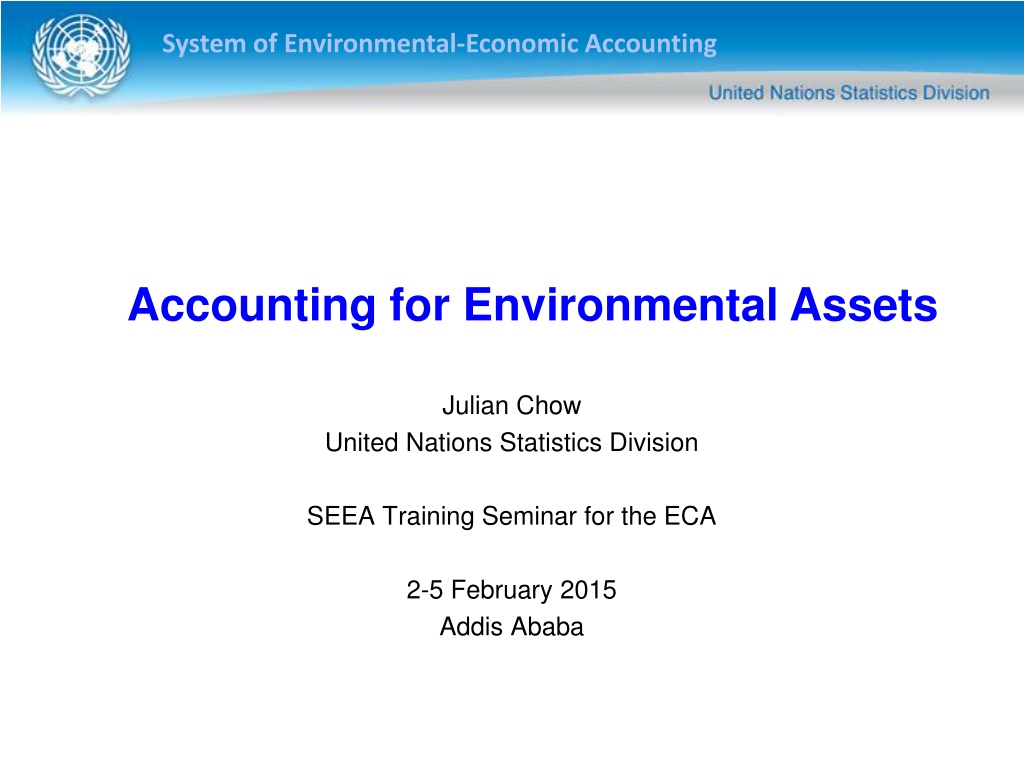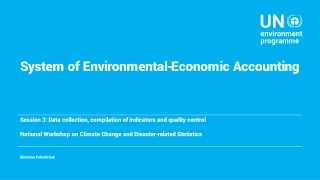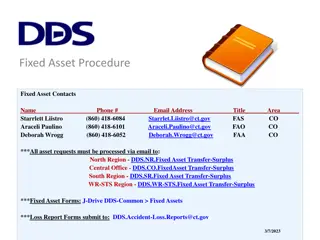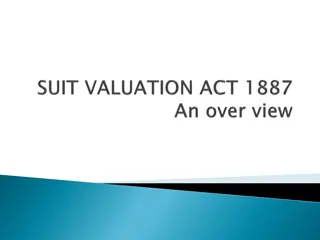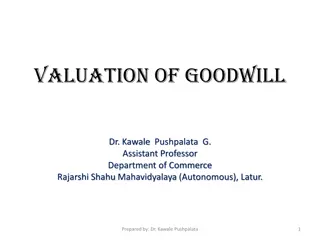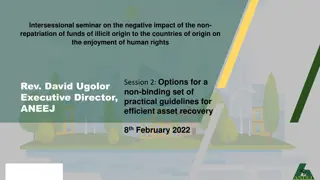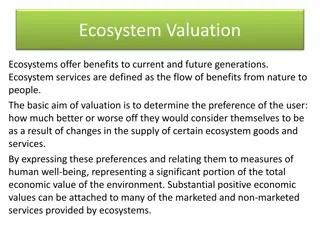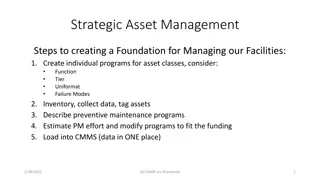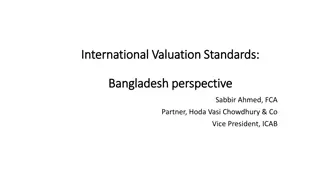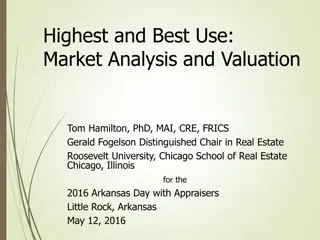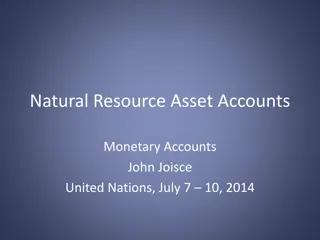Understanding Environmental Asset Accounting and Valuation
Delve into the intricacies of environmental asset accounting and valuation, exploring the definition and scope of environmental assets, the connection between environmental and economic assets, asset account structures, resource depletion definitions, varied valuation approaches, and practical applications. Discover the significance of environmental assets, ranging from individual resources like ecosystems, timber, water, soil, and fish to the broader bio-physical environment that offers benefits to humanity.
Download Presentation

Please find below an Image/Link to download the presentation.
The content on the website is provided AS IS for your information and personal use only. It may not be sold, licensed, or shared on other websites without obtaining consent from the author. Download presentation by click this link. If you encounter any issues during the download, it is possible that the publisher has removed the file from their server.
E N D
Presentation Transcript
System of Environmental-Economic Accounting Accounting for Environmental Assets Julian Chow United Nations Statistics Division SEEA Training Seminar for the ECA 2-5 February 2015 Addis Ababa
System of Environmental-Economic Accounting Objectives of the Day Recap: The definition and scope of environmental assets The link between environmental assets and economic assets The structure of asset accounts The definition of depletion of individual resources The approaches to the valuation of individual resources The possible applications of information from asset accounts
System of Environmental-Economic Accounting Discussion: What Questions or Issues do you have about Accounting for Environmental Assets?
System of Environmental-Economic Accounting Defining Environmental Assets
System of Environmental-Economic Accounting Definition of Environmental Assets Environmental assets are the naturally occurring living and non-living components of the Earth, together constituting the bio- physical environment, which may provide benefits to humanity 2012 SEEA Central Framework 2.17
System of Environmental-Economic Accounting One Environment : Two Perspectives Individual environmental assets / resources Ecosystems Timber Water Soil Fish Forests Lakes Agricultural areas
System of Environmental-Economic Accounting Scope of Individual Resources 1 1.1 1.2 1.3 1.4 1.5 2 3 4 4.1 4.2 5 5.1 5.2 6 7 7.1 7.2 7.3 Mineral and energy resources Oil resources Natural gas resources Coal and peat resources Non-metallic mineral resources (excluding coal and peat resources) Metallic mineral resources Land Soil resources Timber resources Cultivated timber resources Natural timber resources Aquatic resources Cultivated aquatic resources Natural aquatic resources Other biological resources (excluding timber resources and aquatic resources) Water resources Surface water Groundwater Soil water
System of Environmental-Economic Accounting Physical and Monetary Scope In principle, when accounting for environmental assets in physical terms include all environmental assets whether or not they have a monetary value All land in a country is included in physical land accounts Also timber resources, other biological resources, soil, inland water resources Mineral and energy resources scope is known deposits Aquatic resources scope is all resources within EEZ plus rights on high seas In practice limit to commercial stocks and subsistence
System of Environmental-Economic Accounting Key Points and Boundary Issues Distinct treatment of land Account for its provision of space / area not the resources that are within it Include natural and cultivated biological resources Oceans and atmosphere excluded Stocks of potential energy from renewable sources excluded E.g. solar, wind, tidal power Slight exception for hydropower
System of Environmental-Economic Accounting Ecosystem Assets Areas comprising combinations of individual resources (timber, soil, water, etc) but also having ecological processes and characteristics Aim to assess Condition of the ecosystem within an area (i.e. how is it functioning, quality of processes) Flow of ecosystem services to economic and human activity Ecosystem asset accounting measures environmental impact rather than environmental pressures
System of Environmental-Economic Accounting Key Messages Environmental assets can be seen from two perspectives: individual resources & ecosystems Both natural and cultivated resources are included in scope Scope is generally broader in physical terms than in monetary terms Land is accounted for in terms of area/space
System of Environmental-Economic Accounting The Structure of Asset Accounts
System of Environmental-Economic Accounts (SEEA) view Industries Final demand Assets Sectors Financial and produced assets, opening balance Natural resource assets, opening balance Natural resource assets, opening balance Industrial output of goods and services Industrial intermediate demand Gross fixed capital formation Final demand Commodities Environmental protection expenditures Environmental protection expenditures Capital expenditures for environmental protection Resource production by industries Resource production by households/gov t Resource use by industries Resource use by households/gov t Waste consumption by industries Waste consumption by households/gov t Wastes Waste output by industries Waste output by households/gov t Other changes in volume & holding gains/losses on financial & produced assets Changes in and holding gains/losses on natural resource assets Changes in natural resource assets Sectors Financial and produced assets, closing balance Natural resource assets, closing balance Natural resource assets, closing balance 13
Connections between SUT and asset accounts Asset accounts (Physical and monetary terms) Industries Households Government Rest of the world Produced assets Environmental assets Opening stock Monetary supply and use table Product-supply Product-use Output Intermediate consumption Imports Exports Household final consumption expenditures Government final consumption expenditures Gross capital Physical supply and use table Natural inputs- supply Extracted natural resources Natural inputs- use Imports of natural resources Output Product- supply Product-use Imports Intermediate consumption Residuals generated by industry Household final consumption Residuals generated by household final consumption Exports Gross capital formation Residuals from scrapping and demolition of produced assets; Emissions from controlled landfills Accumulation of waste in controlled landfills Other changes in volume of assets (e.g. natural growth, discoveries, catastrophic losses) Revaluations Closing stock Residual- supply Residuals received from the rest of the world Residuals-use Collection & treatment of waste and other residuals Residuals sent to the rest of the world Residuals flowing to the environment*
System of Environmental-Economic Accounting Basic Asset Account Structure
System of Environmental-Economic Accounting Reappraisals and Reclassifications Reappraisals: changes due to use of updated information to reassess physical size of the stock Changes in quality Changes in technology to permit additional extraction May imply revisions Reclassifications: where an environmental asset is use for a different purpose particularly permanent changes in land use Decrease in one category leads to increase in another
System of Environmental-Economic Accounting Accounting structure Structure: conforms with a balance sheet structure - opening stocks, closing stocks and annual variations
System of Environmental-Economic Accounting Asset accounts Asset accounts Topics covered (detailed definition) Mineral and energy resources Physical and monetary accounts for minerals and energy stocks (oil, natural gas, coal and peat, non-metallic minerals and metallic minerals) (CF 5.172) Land Physical and monetary accounts for land, land cover, land use and forest (CF 5.235) Soil resources Area and volume of soil resources (CF 5.318) Timber resources Physical and monetary accounts for timber resources (CF 5.343) Aquatic resources Physical and monetary accounts for fish, crustaceans, molluscs, shellfish and other aquatic organisms such as sponges and seaweed as well as aquatic mammals such as whales. (CF 5.393) (CO2, pollutants) (CF 3.233) Other biological resources Cultivated animals and plants including livestock, annual crops such as wheat and rice, and perennial crops such as rubber plantations, orchards and vineyards. (CF 5.462) Water resources Stock of water resources (CF 5.471)
General structure of the physical account for environmental assets (physical units) Mineral & energy resources Land (incl. forest land) Soil resources Timber resources Aquatic resources Water resources Cultivated Natural Cultivated Natural Opening stock of resources Yes Yes Yes Yes Yes Yes Yes Yes Additions to stock of resources Growth in stock na Yes* Soil formation Growth Natural growth Growth Natural growth Precipitation Soil deposition Return flows Discoveries of new stock Yes na na na na Yes* Yes* Yes* Upwards reappraisals Yes Yes Yes* Yes* Yes* Yes* Yes Yes* Reclassifications Yes Yes Yes Yes Yes Yes Yes Yes Total additions to stock Reductions in stock of resources Extractions Extractions na Soil extraction Removals Removal Harvest Gross catch Abstraction s Normal reductions in stock na na Erosion Natural losses Natural losses Normal losses Normal losses Evaporation Evapotranspiration Catastrophic losses Yes* Yes* Yes* Yes Yes Yes Yes Yes* Downwards reappraisals Yes Yes Yes* Yes* Yes* Yes* Yes Yes* Reclassifications Yes Yes Yes Yes Yes Yes Yes na Total reductions in stock Closing stock of resources Yes Yes Yes Yes Yes Yes Yes Yes
System of Environmental-Economic Accounting Exercise on Water Resources
Atmosphere 54 215 80 21250 50 124 50 246 23015 476 640 90 The economy Rivers and streams 5000, T1 Lakes 2700, T1 Artificial Reservoirs 1500, T1 Soil water 500, T1 Groundwater 100000, T1 17650 56 180 700 890 280 1054 141 9430 10000 Other territories The Sea
System of Environmental-Economic Accounting Solution Type of water resource Surface water Total Groundwater Soil water Artificial reservoirs 1500 Lakes Rivers and streams 5000 Glaciers, snow and ice 0 Opening Additions 2700 100000 500 109700 Returns Precipitation Inflows from other territories Inflows from other inland water resources Discoveries of water in aquifers 56 56 124 246 50 23015 23435 17650 2664 0 43805 17650 640 1054 700 180 90 Total additions to stock 1178 946 18340 0 236 23105 Reductions Abstraction 280 141 476 50 947 0 0 21599 9430 10000 3554 45530 107975 for hydro power generation for cooling water Evaporation & actual evapotranspiration Outflows to other territores Outflows to the sea Outflows to other inland water resources 80 215 54 9430 10000 1754 21379 1961 21250 890 1250 1428 640 855 2791 90 566 99670 180 21480 2125 Total reductions in stock Closing 0 0 23
System of Environmental-Economic Accounting Example: Land accounting
System of Environmental-Economic Accounting Motivation of land accounting Assessment of the ownership and use of land as part of economic production process Assessment on various issues such as impacts of urbanization, sustainability of agricultural and forestry, the use of inland water resources, biodiversity conservation, etc. Assessment of national and institutional sector wealth Provide indicators of change (e.g. land use and land cover) and allow trade-off analysis Unlock the power of GIS to locate areas of change and map a wide range of social, economic and environmental information Fundamental to ecosystem accounting
System of Environmental-Economic Accounting Key components in land accounting Land accounts register the state of land cover at certain time (called land stocks) in terms of extent (area) and type; changes between two steps in time (called land flows) Key components of land accounting include land cover types and their functions or uses (ecological, economic, social) at broader scale land ownership and tenure at finer scale.
System of Environmental-Economic Accounting Important definitions Land: A unique environmental assets that delineates the space in which economic activities and environmental processes take place and within which environmental assets and economic assets are located (SEEA Central Framework para 5.239) Land cover: refers to the observed physical and biophysical cover of the Earth's surface and includes natural vegetation and abiotic surfaces (SEEA Central Framework para. 5.257) Land use: reflects the activities undertaken and the institutional arrangements put in place for a given area for the purpose of economic production, or the maintenance and restoration of environmental functions (SEEA Central Framework para. 5.246) 27
System of Environmental-Economic Accounting International guidance of land accounting SEEA Central framework section 5.6 Asset accounts for land SEEA-Experimental Ecosystem Accounting section 4.3 Compiling ecosystem asset accounts CBD s Quick-Start Package on Ecosystem natural capital accounting chapter 4 The Land Cover account Technical guidance on land accounting (currently developed as part of SEEA Implementation programme) 28
System of Environmental-Economic Accounting Physical assets accounts for land in SEEA Central Framework Objective: Describe the area of land and changes in the area of land cover over an accounting period Types of land accounts Land cover Land use Land ownership by industry or institutional sector Measurement units: Units of areas such as hectares or squares metres
System of Environmental-Economic Accounting Physical assets accounts for land: properties General, a country s area will remain unchanged from one period to the next Changes between the opening and closing stock of land in physical terms Primarily encompass changes between different classes of land Exceptions: Reclamation of land Land subsidence or high water level Political reasons: war, disputed territory
System of Environmental-Economic Accounting Land cover classification Land cover classification system v3 (LCCS 3) developed by FAO Includes land and inland waters
System of Environmental-Economic Accounting Land cover basic rules
System of Environmental-Economic Accounting Physical accounts for land cover (hectares) Total opening stock = Total closing stock Increase of land cover type due to human activity Increase in area resulting from natural process Reflect changes due to the use of updated information that permits a reassessment of the size of different area of land cover. E.g. new satellite imagery or interpretation of satellite imagery Decrease of land cover type due to human activity Decrease in area resulting from natural process
System of Environmental-Economic Accounting Land cover change matrix (hectares) Total opening area = Total closing area Grassland and tree-covered area converted to cropfield over a period of time
System of Environmental-Economic Accounting Classification of land use Classification of land use (interim) in the SEEA Central Framework 4-digit level classification Land 1 3 Coastal waters 1.1 Agriculture 3.1 Coastal waters used for aquaculture or holding facilities 1.2 Forestry 3.2 Coastal waters used for maintenance and restoration of environmental functions 1.3 Land used for aquaculture 3.3 Other uses of coastal waters 1.4 Use of built-up and related areas 3.4 Coastal waters not in use 1.5 Land used for maintenance and restoration of environmental functions 1.6 Other uses of land n.e.c. 1.7 2 Land not in use Inland waters 4 Exclusive economic zone (EEZ) 2.1 Inland waters used for aquaculture or holding facilities 4.1 EEZ areas used for aquaculture of holding facilities 2.2 Inland waters used for maintenance and restoration of environmental functions 4.2 EEZ areas used for maintenance and restoration of environmental functions 2.3 Other uses of inland waters n.e.c. 4.3 Other uses of EEZ areas n.e.c. 2.4 Inland waters not in use 4.4 EEZ areas not in use
System of Environmental-Economic Accounting Monetary asset account for land by type of and use (currency units) Acquisition (additional to stock) and disposal (reduction of stock) of land are recorded when transactions in environmental assets take places between institutional units in different sectors. Reclassifications occur in situation in which land is used for different purpose.
System of Environmental-Economic Accounting Data Visual photo-interpretation of satellite images National cartographic sources of land-cover information National field survey 38
System of Environmental-Economic Accounting Existing global sources of land cover maps Non-exhaustive list: Global land cover information service (for 2000 and 2010, at 30m, based on Landsat, mapped by China): MODIS Land cover (annual since 2001, at 250m, by NASA): GlobCover (for 2005 and 2009, at 300m, based on MERIS, European Space Agency): Global Land Cover-SHARE (compilation of the available best data sources for land cover from the countries, at 1km, by FAO): Issues: Problems of spatial accuracy and details Lack of time series
System of Environmental-Economic Accounting Exercise on Timber Resources: Q1
System of Environmental-Economic Accounting Depletion of Environmental Assets
System of Environmental-Economic Accounting Depletion and Sustainable Yield Sustainable yield curve Harvest Minimum viable population Carrying capacity Population size
System of Environmental-Economic Accounting Definition of Depletion Depletion, in physical terms, is the decrease in the quantity of the stock of a natural resource over an accounting period that is due to the extraction of the natural resource by economic units occurring at a level greater than that of regeneration 2012 SEEA Central Framework 5.76
System of Environmental-Economic Accounting Key Points Depletion must be a physical flow before valuation takes place Monetary estimates equal physical flow * average price of resource before extraction Only for natural resources not cultivated resources Only extraction by economic units not all reductions in stock Discoveries of non-renewable resources are not considered regeneration Depletion will generally not equal change in the value of the stock Depletion is distinct from degradation which reflects reductions in the functioning of ecosystems
System of Environmental-Economic Accounting Exercise on Timber Resources: Q1
System of Environmental-Economic Accounting Monetary Valuation
System of Environmental-Economic Accounting Defining Economic Assets Economic owner: The institutional unit entitled to claim the benefits associated with the use of an asset in an economic activity Economic benefits Include operating surplus from sale of extracted resources, rent earned by allowing use of resources, receipts from sale of assets Economic asset Store of value representing the benefit or series of benefits accruing to the owner by holding or using the asset over time
System of Environmental-Economic Accounting Economic and Environmental Assets ECONOMIC ASSETS Produced assets - Fixed assets & inventories ENVIRONMENTAL ASSETS Natural resources & land with no economic benefits (e.g. barren land, known mineral deposits without current economic value) - Cultivated biological resources Non-produced assets - Contracts, marketing assets, etc. - Natural resources & land Financial assets
System of Environmental-Economic Accounting Valuation Principles & Methods Value at balance sheet date (e.g. end of financial year Value using market prices Market prices are amounts of money that willing buyers pay to willing sellers Exchange prices/value or transaction prices generally observable If prices not observable need to determine a price that would be applicable if a market had existed
System of Environmental-Economic Accounting Methods for Estimating Market Prices Market price equivalents Prices for similar products or assets Written down replacement costs Used for buildings and machines equal to the original purchase price adjusted for depreciation and the current replacement cost Net present value (NPV) Assess the value of the future flow of benefits (income) from using or owning the asset
